- Qualcomm Launches Snapdragon 4 Gen 2 Mobile Platform
- AMD Launches Ryzen PRO 7000 Series Mobile & Desktop Platform
- Intel Launches Sleek Single-Slot Arc Pro A60 Workstation Graphics Card
- NVIDIA Announces Latest Ada Lovelace Additions: GeForce RTX 4060 Ti & RTX 4060
- Maxon Redshift With AMD Radeon GPU Rendering Support Now Available
A Look At ADATA’s SU900 512GB SSD

While ADATA has a wide variety of budget SSDs on offer, it also has a growing number of more premium offerings. Under review today is one such drive, the SATA-based SU900, an MLC drive with a five-year warranty. Let’s see how it performs compared to other drives in the same budget range.
Page 2 – Test Suite, PC Mark, Iometer & AS SSD
Benchmark Programs
Futuremark PCMark 08: Normal settings are used including the default setting of three runs. This gives us an extended test that takes roughly 45 minutes to complete, resulting in a sustained load that will thermally challenge drives. The free (demo) version is available on Steam for general use.
AS SSD: This handy little utility was custom-written for solid-state drives. We selected this program as by default it utilizes incompressible data and bypasses the Windows cache. This is another free program anyone can use to quickly test or verify normal performance of an SSD, available here.
ATTO: The bar graphs generated by this utility provide a huge amount of data in a condensed format. It is extremely handy for detecting problematic file sizes, performance bottlenecks, or simply inconsistent performance that can be hidden when viewing final performance averages. Though this is significantly less of a problem today as solid-state drives have matured, it remains an essential performance verification tool of any benchmark kit.
RoboCopy: This is Windows’ command-line utility included in most versions of Windows and provides for features beyond the default file copy handling of Windows Explorer. More information is available here. Windows Defender is also disabled to prevent bottlenecking the folder copy. We utilize a 9.81GB Movie file, and separately a 1.6GB Folder with 11,511 files across 449 subfolders and measure the performance to copying the data to and from a RAMdrive.
RAMdrive: Primo Software’s Ramdisk utility is a handy, convenient way to create a 12GB direct-IO ramdisk, meaning no indexing or caching is utilized and removes any bottlenecks associated with utilizing another storage device. File performance of the RAMdrive varies by I/O size but exceeds 6GB/s above 16KB IOPS with an overall peak of 12GB/s.
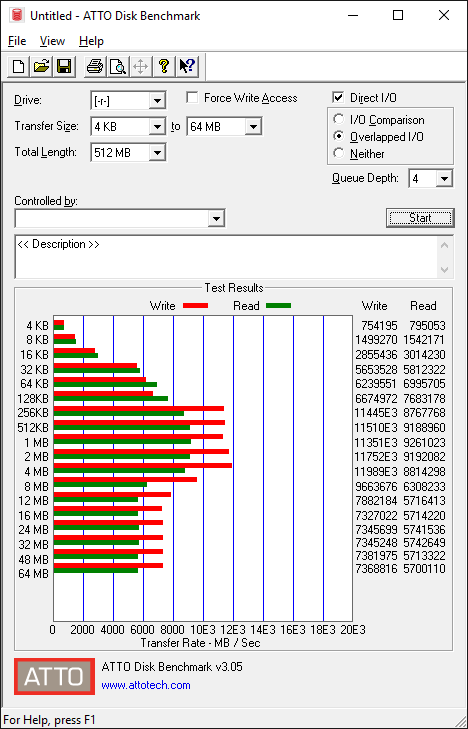
dBpoweramp R15.3: We transcode 500 FLAC encoded music files (14.4GB) into .M4A with the Apple Lossless Audio Codec (ALAC) for playback on Apple devices. As no lossy compression is taking place, this minimizes the CPU workload while maximizing the amount of data written to the destination drive. Unfortunately this test is bottlenecked by our quad-core processor and would show more variance in results for systems with greater than four cores as dBpoweramp can fully load almost any size processor.
IOmeter – The most powerful piece of storage testing software freely available, IOmeter allows the creation of practically any kind of test workload. We first utilize it to dirty every new SSD before we test the four basics of every solid-state drive. We measure random 4K read and writes at 1QD and 32QD, as well as 2MB sequential read and writes with a queue depth of one. Each one of the six tests is run with a ten minute duration.
Additionally we have added Database, File Server, and Workstation scenarios back into our regular testing. We have updated and modified the original three workload scenarios to bring them more in line with changes in workloads, access patterns, and disk IO sizes. These results are not comparable to the test scripts originally created and included with IOmeter nearly two decades ago.
Footnote – Disk I/O Tracing
If you are still reading our benchmark profile, thank you! It is not easy to devise tests that can tax a modern solid-state drive so if you have any suggestions or perhaps know of any applicable software that you would like to see added to our test regimen, please let us know. We are especially eager to add disk I/O trace recording and playback to replace the batch file testing we utilized in past storage reviews. We are still looking into how to make this possible, so if you know of a piece of software that doesn’t cost a few grand please drop us a note!
Futuremark PCMark 8
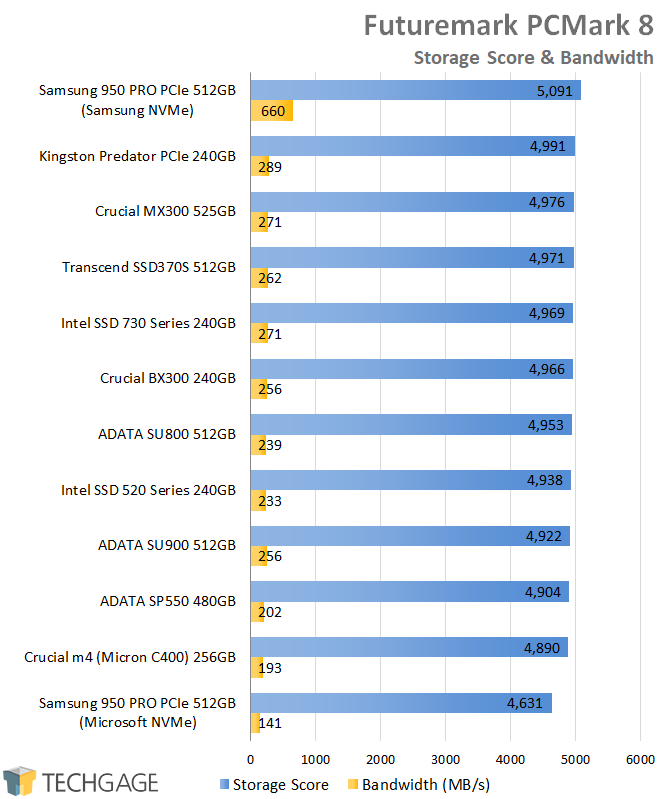
As we expected the SU900 offers 256MB/s in bandwidth, higher than the SU800 which achieved 239MB/s yet Futuremark still gave the SU800 a higher overall score. While 31 points is negligible it is still perplexing as the results were repeatable. A difference in how the two drives allocated their respective pseudo fast-write SLC caches may be in play. 256MB/s ties it with the BX300 and places it just behind the Transcend, both of which also utilize MLC NAND.
Iometer 2010 1.1.0
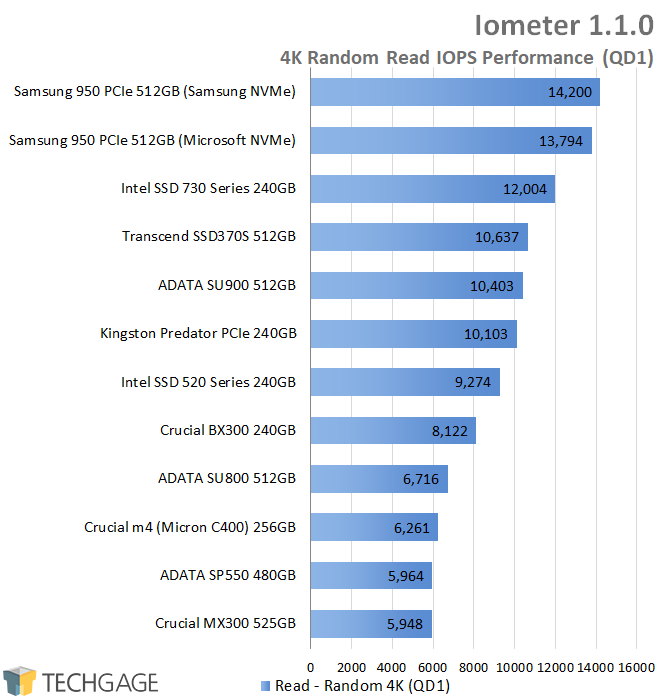
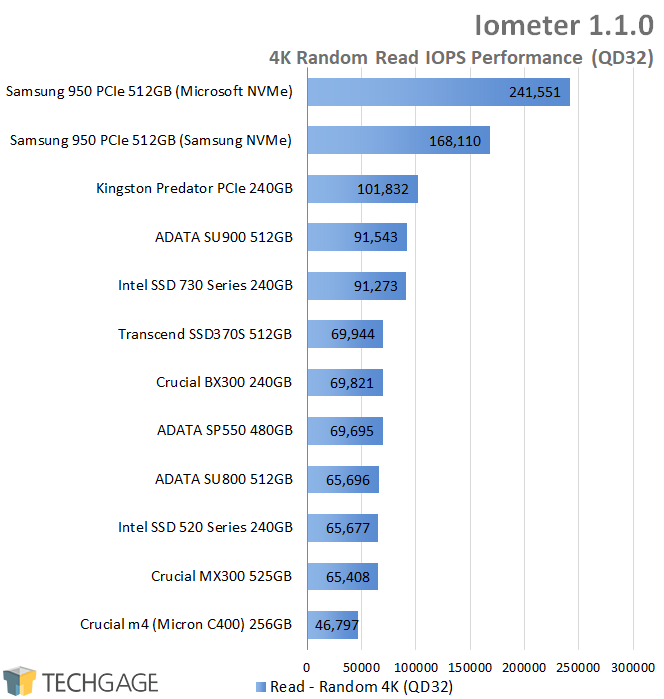
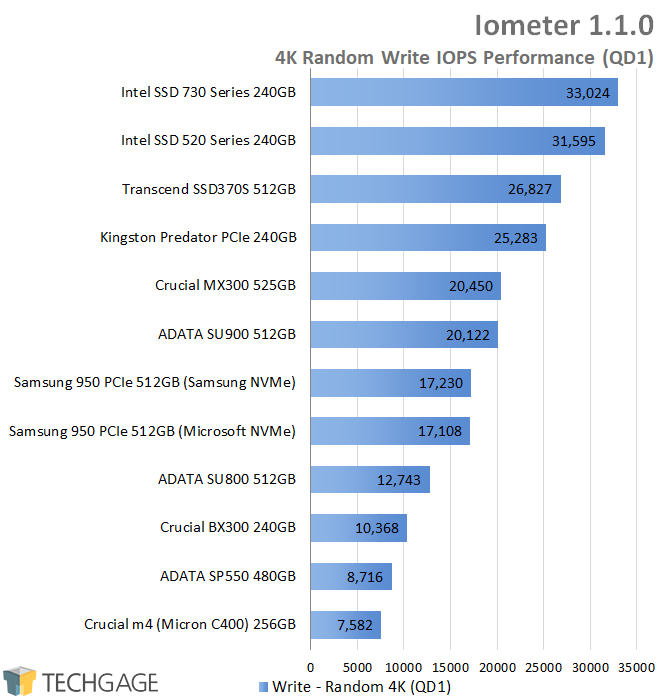
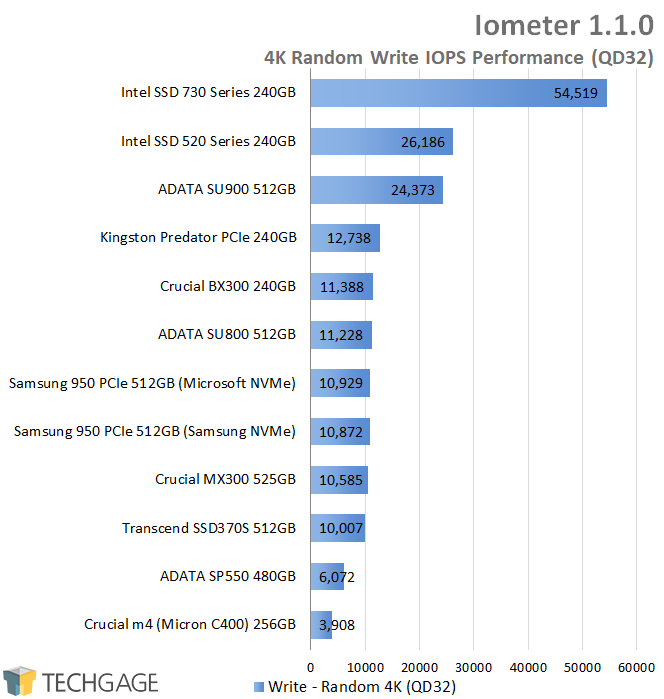
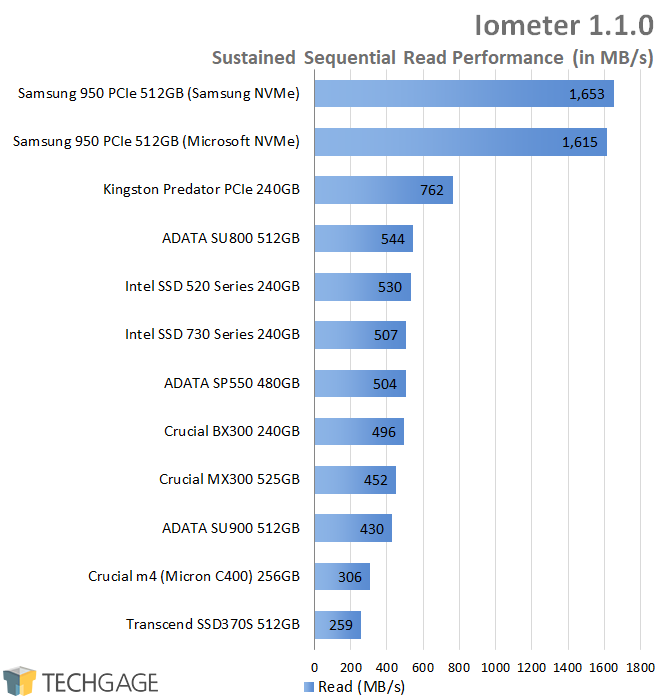
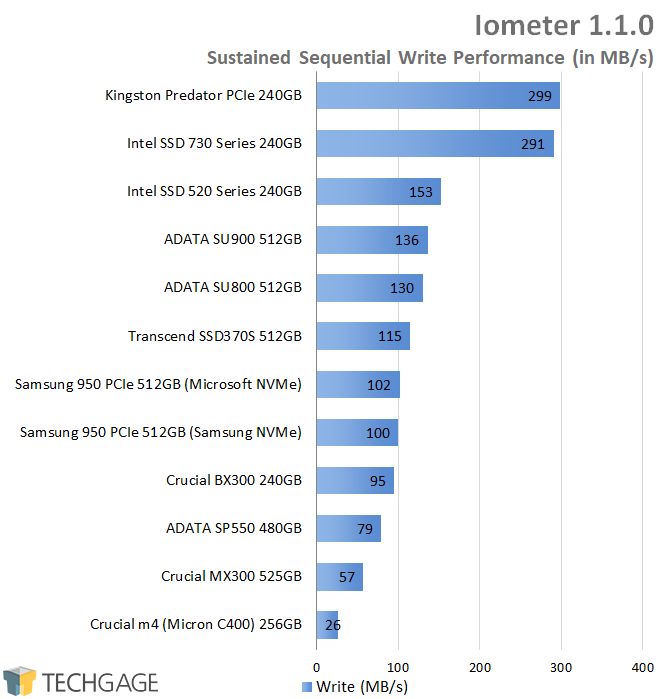
One thing to keep in mind is Iometer creates a test file that spans the entire size of the SSD. So it should come as no surprise that this mostly negates the SLC caching performance of the BX300 and other SLC-caching drives. While this allows us to see the raw performance of the NAND, ten minute saturation workloads are not even close to representative of the sort of work consumer drives would see in normal consumer use.
With that caveat out-of-the-way the S900 delivers strong performance. The Random 4K Read IOPS is in on par with the stronger drives, but when increasing the queue depth to 32 the drive is able to take the top spot in the SATA drives we have tested, only just below the M.2 drives that aren’t limited by the SATA interface bottleneck.
Performance continues to be strong in every test save the sequential read result, though for sequential writes the SU900 is able to inch out just ahead of the SU800 as we would expect. Iometer is not a consumer-drive friendly program, but the strong QD32 results the SU900 delivers makes it pretty clear the drive is quite capable of handling the heaviest multitasking workloads consumers might have.
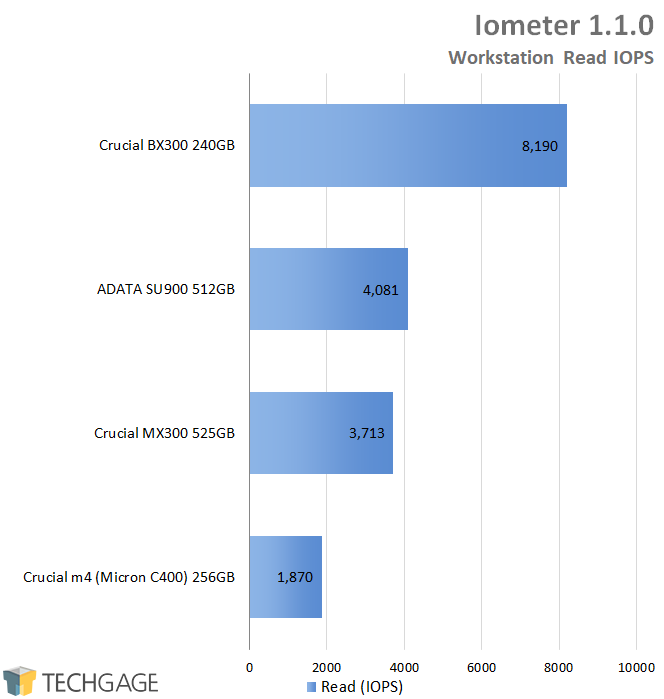
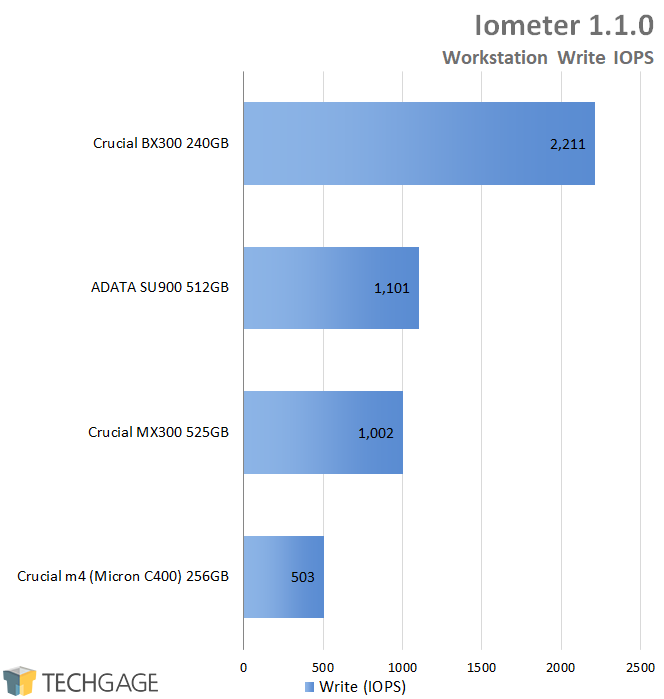
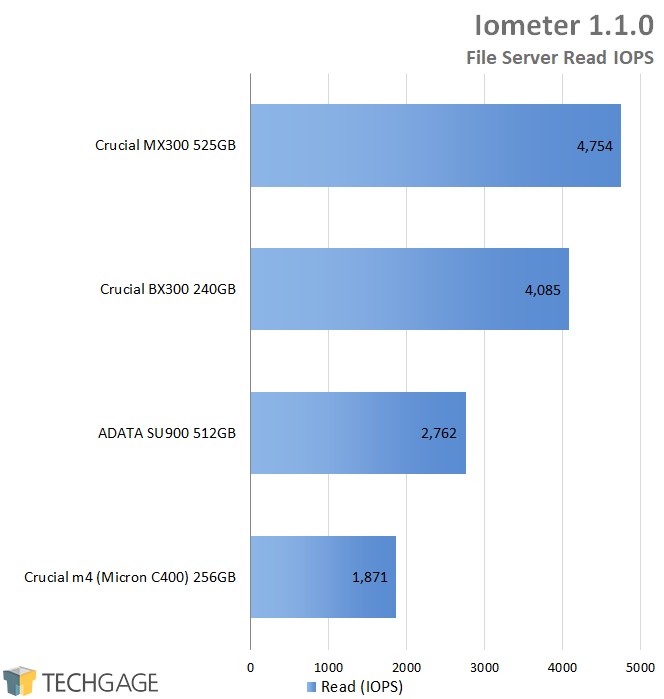
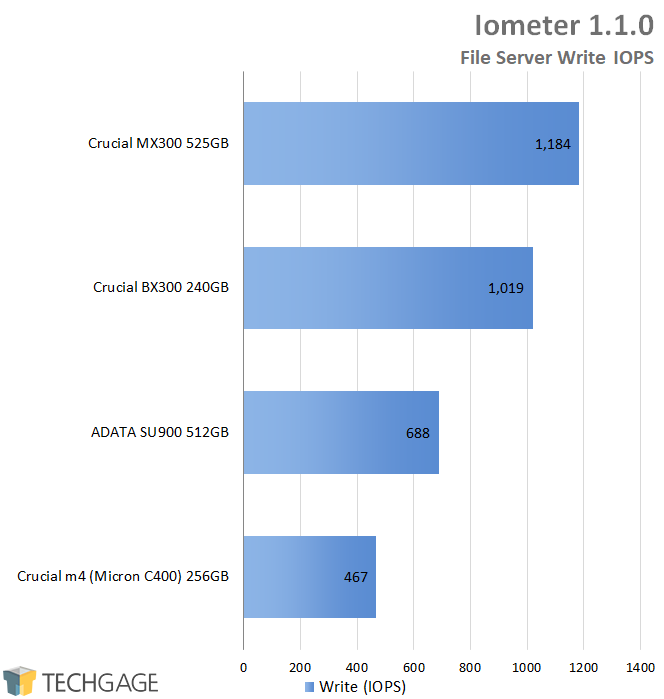
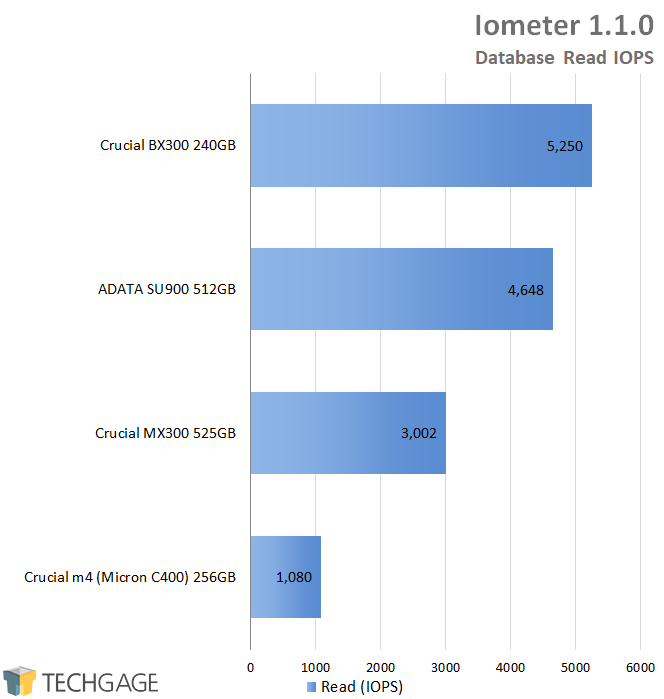
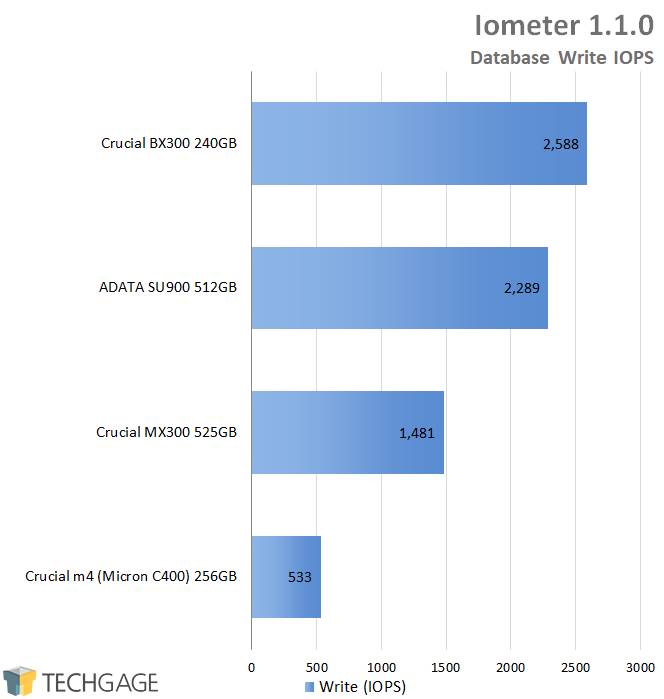
Our new Iometer scenarios are more appropriate for enterprise and data-center SSDs, but due to the dearth of consumer programs that will stress modern SSDs, we have recreated the original Iometer usage scenarios with some modern, updated settings.
Each of the three scenarios runs for twenty minutes each with minimal time given between runs for the SSD to perform maintenance tasks like garbage cleanup or clearing any SLC fast-caches (if applicable). These tests are a worst-case scenario intended to highlight the underlying differences between solid-state drives that are well-hidden by new technologies such as fast-write SLC caching.
The SU900 is the first ADATA drive to endure these three scenarios and once again puts up a strong showing, taking second spot in the Workstation scenarios, though dropping to third in the file server results. Sustained low queue depth writes will eventually fill up any SLC cache, making it moot, which is what happened here. We can’t imagine most consumers buying these drives would use them as file servers anyway. The SU900 recovers with a very good finish in the Database scenario, with results close to the BX300.
The seven-year-old Crucial m4 SSD does not have an SLC fast-cache and even for its time did not have the best random IOPS performance. As far as intensive workloads are concerned, users on some of the early generation SSDs may see tangible benefits to upgrading to a modern solid-state drive.
AS SSD

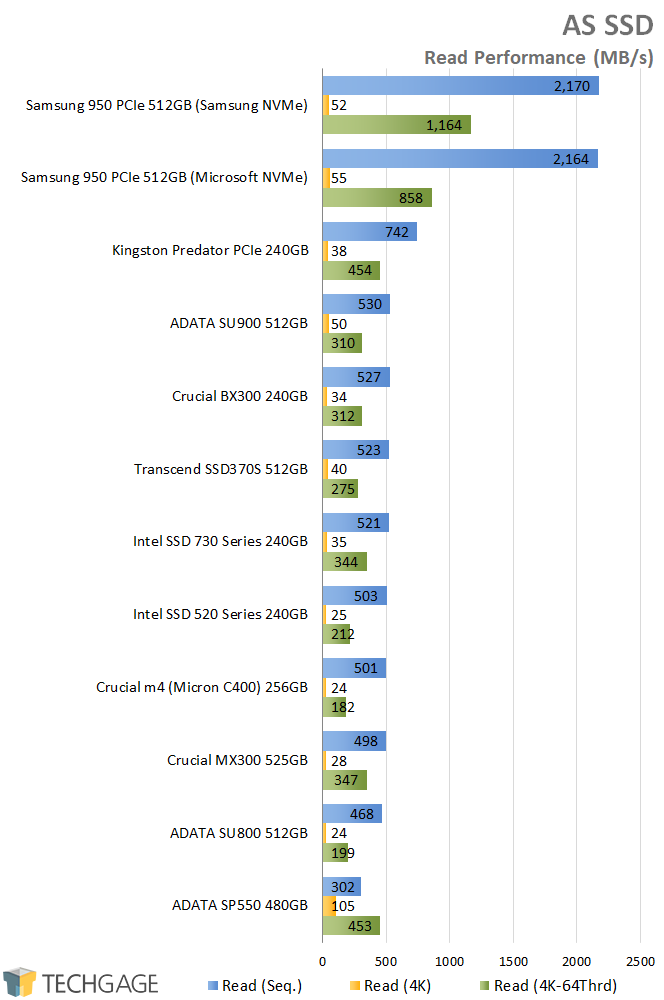
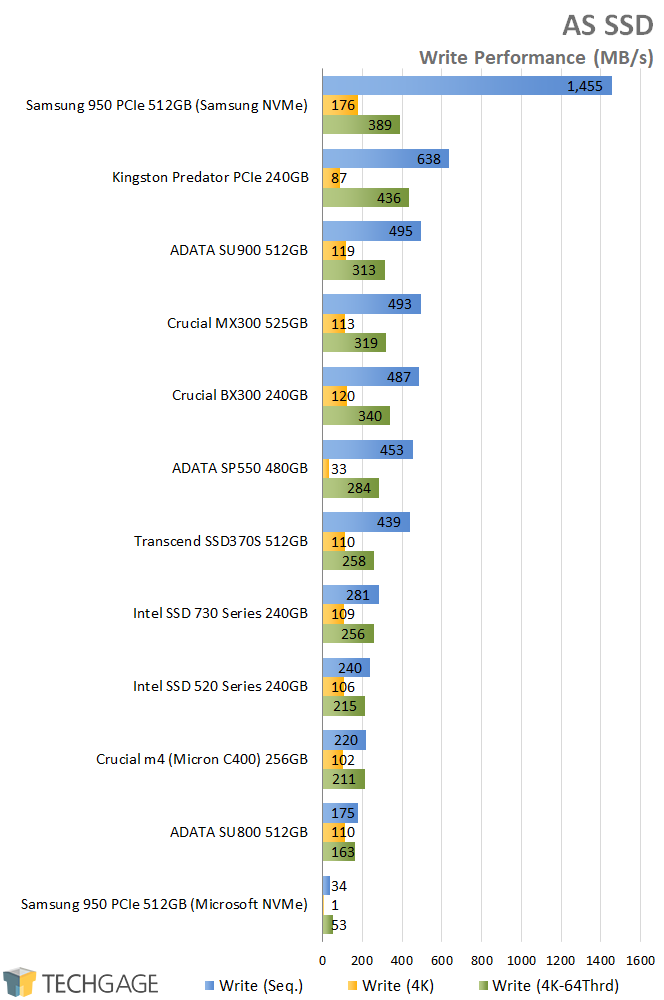
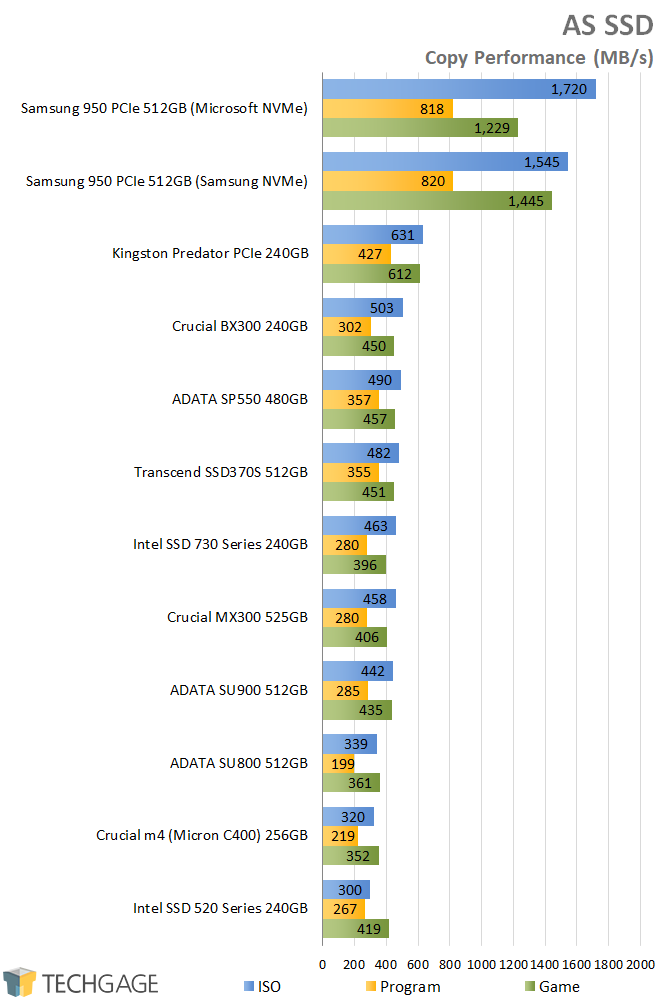
| AS SSD – Latencies | Read | Write |
| ADATA SP550 (480GB) | 0.035ms | 0.034ms |
| ADATA SU800 (512GB) | 0.032ms | 0.035ms |
| ADATA SU900 (512GB) | 0.032ms | 0.037ms |
| Crucial BX300 (240GB) | 0.031ms | 0.029ms |
| Crucial MX300 (525GB) | 0.043ms | 0.527ms |
| Crucial m4 (Micron C400) (256GB) | 0.037ms | 0.049ms |
| Intel 520 (240GB) | 0.110ms | 0.173ms |
| Intel 730 (240GB) | 0.032ms | 0.032ms |
| Kingston Predator (240GB) | 0.041ms | 0.047ms |
| Samsung 950 PRO (Microsoft NVMe) | 0.027ms | 2.670ms |
| Samsung 950 PRO (Samsung NVMe) | 0.023ms | 0.021ms |
| Transcend SSD370S (512GB) | 0.032ms | 0.035ms |
The upgrade to MLC NAND makes a stark difference with AS SSD, with the SU900 pulling far ahead of the SU800 in practically every result. Though it is unable to overcome the SLC caching of the Crucial drives in the final tally, it is able to score higher than Intel’s 730 drive and all other SATA drives in our tests. AS SSD is coded to ignore Windows caching, though it defaults to a 1GB test file which fits easily within most SLC fast-caches today. As expected, given the identical controllers, the SU900 posts identical latency results to its cheaper SU800 sibling.
Support our efforts! With ad revenue at an all-time low for written websites, we're relying more than ever on reader support to help us continue putting so much effort into this type of content. You can support us by becoming a Patron, or by using our Amazon shopping affiliate links listed through our articles. Thanks for your support!




